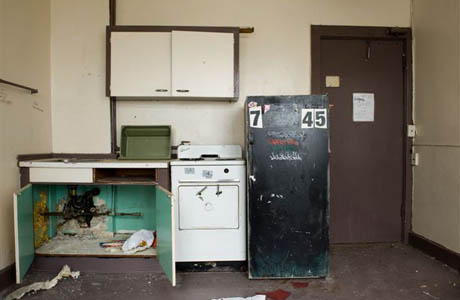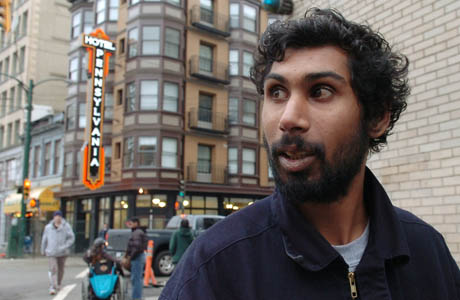Where top dollar buys squalor
Lora Grindlay
Province

You’d pay $3.90 per sq. ft. to rent a room like this on the Downtown Eastside. Photograph by: Handout, BC Housing

You’d pay $2.90 per sq. ft. to rent this luxurious penthouse. Photograph by: Handout, Adventvancouver.com

Mark Smith, executive director of RainCity Housing. Photograph by: Arlen Redekop, The Province

Sukhjit Khaira, 28, born in Richmond. Lives in a $325-a-month room at the Portland Hotel. On income assistance. Khaira, who is schizophrenic, was homeless and in and out of shelters for two months before getting a room at the Portland. “I got a shower and a bathroom. I’m pretty much housed now. I’m warm. I’ll be there for a while.” Photograph by: Arlen Redekop, The Province
Incredibly, Downtown Eastsider SRO renters pay more than luxury penthouse residents
Single-room-occupancy hotels are just as vital as they are the scourge of the Downtown Eastside.
They’re widely thought of as the city’s cheapest accommodation, but in fact 100 square feet (the average size of an SRO unit) of squalor in the Downtown Eastside costs more per square foot to rent than almost anything else in the city, including the most luxurious and well-appointed condos.
According to the City of Vancouver‘s most recent low-income housing survey, in 2007, residents in the downtown area’s 5,916 SRO units were paying an average of $389 per month in rent. For the square feet they get, that is very high and has much to do with the very limited number of building owners who are prepared to rent to them.
The SROs have always been the housing of last resort for the poor. But in recent years they’ve become a refuge for people known as “hard to house” — those with mental illness or addictions whose behaviours make it impossible for them to rent from any private landlord outside of the Downtown Eastside.
“It’s both about poverty and it’s about what people look like and what they do and who will rent to them,” said Janice Abbott, head of Atira Property Management, which manages some of the 25 downtown hotels now owned or leased by B.C. Housing.
The hotels are “a necessary evil,” said Jim Frankish, a University of B.C. professor who specializes in homelessness research.
“The fundamental solution to homelessness is homes,” he said. “There’s nothing that poor people can afford to rent. The vacancy rate is very low. They are faced with the choice between these truly disgusting hotels and nothing — or homelessness.”
Said Vancouver Mayor Gregor Robertson: “They are critical to the supply of housing units, but the conditions are really sketchy in some buildings and there are people who would rather live on the street.”
It’s bewildering, then, why many have been allowed to fall into such deplorable condition. Despite a city bylaw that demands the most basic of living conditions in buildings and a Residential Tenancy Act designed to protect tenants from unscrupulous landlords, the hotels are home to rampant drug trafficking, welfare fraud, violent assaults and illegal evictions.
A solid majority have bedbugs or rodents, and numerous reports written over the years read like horror stories.
As bad as the conditions are, they’ve been worse, said Judy Graves, co-ordinator of the city’s tenant-assistance program.
“The filth and the stench in the buildings was beyond anything that you see now,” she said.
When Graves returned home after visiting tenants in the hotels in the early ’90s, she would go through her own de-contamination process.
“I’d step inside my door, stand in a garbage bag, take all of my clothes off, tie the garbage bag and have a shower and wash my hair,” she said. “I would put on fresh clothes and launder everything I’d worn that day because everything, everything was covered with little, tiny cockroaches.”
There’s been improvement since then, she said, but not enough. “And now we are fighting a bedbug epidemic.”
Ken Frail, a retired Vancouver police officer who worked in the Downtown Eastside for 12 years, said the SRO hotels create an environment contributing to the area’s underground economy revolving around drugs, stolen property and welfare fraud.
“The condition of those hotels and the way that they are run creates an environment that allows the Downtown Eastside to be sustained,” he said. “The only way the owners can make money is by living off the backs of the poor.”
Frail was also an author of the Hotel Analysis Project for the Vancouver Agreement, a report that found that, in 2005, the 54 SRO hotels that were part of the study generated 11,269 emergency-service calls (police, fire and ambulance), an average of about three calls per room. It was found that, out of 3,100 rooms, 80 per cent had bedbugs and 77 per cent had rodents and/or cockroaches.
The report revealed that Vancouver fire inspectors found 2,283 fire-code violations. In one room inspectors found a working barbeque with a 20-pound propane tank, in another a five-gallon outboard-motor tank full of gas.
In 2003, the City of Vancouver enacted a bylaw to protect SRO hotels from being redeveloped for non-social-housing purposes. In 1997, there were 5,699 units. There are now fewer than 5,000. Owners have to apply to council before converting or demolishing any of 184 designated downtown SRO buildings. Council can charge a fee of $15,000 a room for permits. Critics of the bylaw say it doesn’t prevent owners from evicting tenants and shutting their doors, which can make the building more attractive to buyers.
In order to preserve the housing stock, the province has spent more than $63 million since 2007 on building purchases and now owns or
leases 25 downtown buildings comprising 1,550 living units. It will spend more than $82 million renovating the SRO hotels it has purchased before turning them over to non-profits to run as supported housing. Many have already been renovated and are open; others will follow this year.
B.C. Housing will provide funding for 24-hour support staff at a cost of about $700,000 for every 50 units. Maintenance will cost an additional $200,000 a year for every 50 units.
Minister of Housing and Social Development Rich Coleman said having support staff providing care and links to services is necessary for positive outcomes.
“We have examples of people who have been in and out of the hospital and mental-health system as many as 100 or 200 times a year that haven’t been back because they finally got supports that helped them with their mental-health issues, helped them with their addictions issues and turned them around,” Coleman said.
The minister said there are about 200 severely mentally ill and addicted people in the Downtown Eastside who can’t function in supported housing. For that population, B.C. Housing teamed up with the health ministry last summer to open the Burnaby Centre for Mental Health and Addiction, which provides long-term clinical care. Plans are under way for a similar facility in the Fraser Valley.
Atira’s Abbott said SRO rooms aren’t considered permanent or ideal housing, because most lack private bathrooms or kitchens.
“Imagine if you had to share a bathroom your whole life with 72 people?” she said. “You are poor. Food is an issue if you don’t have anywhere to store it or cook it. It just adds to your poverty.”
© Copyright (c) The Province
Penthouse a steal compared to an SRO
In the Downtown Eastside, a typical 100-square-foot SRO room — simply four walls with a separate shared bathroom and kitchen that are not always in working order — rents for about $400 a month, or $4 per square foot.
A quick comparison with some swanky rental properties currently advertised in Vancouver shows that many SRO tenants are paying a fortune for the most unsafe and decrepit housing in town.
Take the penthouse suite atop The Melville in Coal Harbour. With spectacular views and a long list of luxuries, it is available at $5,500 a month for its 1,890 square feet, or $2.91 per square foot. Downtown Eastsiders on welfare pay more per square foot than that and they don’t get swimming-pool access, two parking bays, granite counter-tops or a separate wine cellar.
Or try the 1,380-square-foot, open-style penthouse in Gastown’s Koret Lofts that’s advertised at $3,500 a month. With its great views of the North Shore mountains, it rents for $2.54 per square foot.
The money for the apparent $4-per-square-foot extravagance comes from the B.C. government, which, at the last count in 2007, was paying income assistance to 7,100 people in the Downtown Eastside. Of those, 5,200 received the maximum monthly support of $960 a month, which consists of a $375 shelter allowance, a $230 support payment and $350 for their disability. The remainder got the $610 basic welfare amount. All of these people pay at least their shelter allowance directly to landlords.
© Copyright (c) The Province
Better or worse? Mark Smith responds
Mark Smith Executive director, RainCity Housing
We asked two questions:
1) What are the key issues facing the Downtown Eastside? and
2) Are things getting better or worse?
1. Homelessness, mental health and addiction are the key issues in the Downtown Eastside. In our experience, these issues are due to unimaginable trauma suffered by so many of the people we work with and house. Supported housing that addresses their complex health needs is the foundation on which we build solutions. Many of the homeless are unable to maintain housing because of their substance use, untreated mental illness or involvement in sex work. At RainCity Housing we believe in housing such people. If you simply evict people for their survival behaviour, you never get the chance to connect them with the world in a different way. People don’t behave in a vacuum. There is always a reason for the behaviour — no one just wakes up one day and decides to be a mentally ill substance user.
2. Things are getting better and worse. There have been improvements to the quality of housing available. Unfortunately, the quantity of housing is under tremendous pressure. We have a vacancy rate of 0.6 per cent and construction workers arriving from Calgary. They have money and references, so they stay at SROs until they can find something better. Meanwhile the homeless don’t get housed at all.
© Copyright (c) The Province
‘There were wall-to-wall rats’
Various states of disgusting. Crazy, deplorable stuff. Something out of a Charles Dickens novel. Horrendous. Absolutely shocking. Beyond compare.
Those are just some of the ways housing advocates describe what was found behind the doors of many of the single-room-occupancy (SRO) hotels in downtown Vancouver that B.C. Housing has bought or leased in recent years.
Structurally, most of the previously privately owned buildings were death traps. Beams holding up the Walton Hotel at 265 East Hastings were soft to the touch, rotten to the core. If left that way much longer, the building would have collapsed.
Very few had working smoke alarms, accessible fire escapes or toilets that worked. Plumbing was so corroded and old that it crumbled when touched.
Bathrooms were filled with mould and slime. Heating systems rarely worked and the buildings were smelly and stifling in the summer due to a lack of ventilation.
And then there were the mice, rats, bedbugs and cockroaches. In some of the hotels, all of which are about 100 years old and are rooming houses originally built for short-term stays by miners, loggers and fishers, one couldn’t walk down the hall without stepping on cockroaches. They were always underfoot.
Janice Abbott, executive director of Atira Women’s Resource Society, whose property-management arm now manages 11 of the SRO hotels taken over by the provincial government, recalls being in the Gastown Hotel at 110 Water Street last year.
The Gastown and its 95 units were purchased early last year for $5.2 million.
“The ground floor was alive with rats. The whole floor was undulating with rats. There were wall-to-wall rats,” said Abbott.
It cost $40,000 to spray the Gastown for bedbugs. All the beds had to be thrown away.
And then there were the bathrooms at the 96-unit St. Helen’s Hotel at 1161 Granville Street. The province paid $7.5 million for it in 2007.
“There was plastic stapled up over the framing in the showers. You could see in behind about up to your knees was water and in it was floating algae and mould . . . You are basically showering with crap floating behind plastic around you.”
James Weldon, B.C. Housing’s senior manager of building standards, said when he first entered the Carl Rooms at 335 Princess Street, he was met with needles in the stairways and “yelling, screaming and people arguing in the corridors.”
There were also a number of “shell-shocked” people confined to their rooms, he said, targets of physical abuse by resident drug dealers.
“There was an element in that building that was oppressing people. I think people were living with quite a cloud over them, a shadow of abuse,” said Weldon.
Abbott said one resident and rather successful drug dealer had set up his own security system in one of the hotels. He had surveillance cameras set up outside his room and the building.
“Most of the people in the building were scared to come out of their rooms while he was living there because he and his associates were assaulting people,” she said.
At first, Abbott said, management was changed, criminals were evicted and full-on fencing operations were shut down along with staff loan-sharking operations that charged tenants 100-per-cent interest.
Then, said Weldon, the buildings were stabilized. Emergency systems were repaired, temporary improvements were made to heating and plumbing, massive pest-control programs began and renovations were planned.
“Although we couldn’t fix the buildings immediately — there is no magic wand — just changing the management made a big difference to the good-willed tenants,” said Weldon. “The change was amazing from when we first took over to going back maybe a month later.”
The takeover had begun. Now the front doors were locked to drug dealers and other predators. Crime, which may be hard to totally eliminate, is monitored and police are called.
Tenant-liaison workers have been brought in, mental-health workers and doctors visit and support staff keep an eye on people and offer help when required.
“Just being there and caring” has made such a difference, said Abbott.
“Tenants felt they could trust people. They knew they weren’t going to get manipulated by management.”
© Copyright (c) The Province















